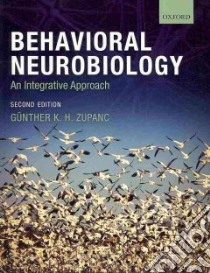- Libreria
- >
- Libri in lingua
- >
- Biologia
- >
- Comportamento degli animali
Behavioral Neurobiology - 9780199208302
Un libro in lingua di Zupanc Gunther K. H. Bullock Theordore H. (FRW) edito da Oxford University Press, 2010
- € 51.50
- Il prezzo è variabile in funzione del cambio della valuta d’origine
Animals often exhibit intriguing and captivating patterns of behavior, from migration and homing to communication. But how is this behavior controlled? Behavioral Neurobiology: An Integrative Approach, Second Edition, introduces undergraduate students to the fascinating field of neuroethology, the study of the neurobiological processes underlying animal behavior. Written in a lively, accessible style, it examines the key ideas that underpin this intricate subject and describes many of the groundbreaking discoveries in the field.
Beginning with a look at the history of the study of behavior--from Aristotle to recent breakthroughs and predictions for the future--the text then reviews the ethological and neurobiological concepts that constitute the basic tools of behavioral neurobiology before moving on to the field of neuroethology itself. Each chapter not only describes the major findings in a specific area, but also examines the experimental methods used to obtain these results and the researchers behind them.
Taking a comparative zoological approach, Behavioral Neurobiology, Second Edition, enables students to gain a thorough understanding of the essentials of the field without becoming overwhelmed by excessive details. The text is enhanced by detailed case studies, a wide range of examples, summaries of key points, biographical sketches of eminent researchers, exercises, and suggestions for further reading. A Companion Website offers additional resources for students and instructors.
New to this edition:
* New "Advanced Topic" features that encourage students to engage with the primary literature and develop critical thinking and reading skills
* A new chapter on circadian rhythms that looks at classical experiments and recent advances in the molecular understanding of biological clocks
* Expanded coverage of action potentials, synaptic transmission, and additional model systems
* Improved figures and an extensive new glossary
Informazioni bibliografiche
- Titolo del Libro in lingua: Behavioral Neurobiology
- Sottotitolo: An Integrative Approach
- Lingua: English
- Autori : Zupanc Gunther K. H. Bullock Theordore H. (FRW)
- Editore: Oxford University Press
- Collana: Oxford Univ Pr (Paperback)
- Data di Pubblicazione: 01 Luglio '10
- Genere: MEDICAL
- Pagine: 371
- ISBN-10: 0199208301
- EAN-13: 9780199208302


